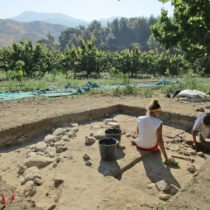Ancient Pydna lies in north Pieria, to the south of Makrygialos. The first settlement of the region, one of the most extensive settlements of the Late Neolithic period, is located to the south-west of Makrygialos. The settlement was built during two periods of time, one part is pre-Diminian, covering an area of approximately 75 acres and bounded by a trench system, and another part of the settlement is contemporary to that of Dlmini. In the Bronze Age the settlement was transferred about 1500 m. south-east to the coast of the Thermaikos bay, where, due to sea erosion, only a small part of the tumulus has survived. In the Early Iron Age the settlement also extended around the tumulus, while later it obtained its maximum expansion. Bounded by a trench, it covered an area of over 50 acres, while during the Archaic period, due to colonization, it diminished considerably. Pydna reached a high point of prosperity in the fifth century BC.In the years of Alexander I (498-45) it expanded even further, covering an area of over 62 acres, a unique size in the Macedonian kingdom of which Pydna was the major port. Its defection and defeat by Archeiaos (413-399) temporarily halted its prosperity. Archeiaos transferred the Pydnaeans to the hinterland, but they soon came back and for a certain period enjoyed autonomy – until 357 BC, when Philip resubmitted the city to the Macedonian sphere of influence. The rise of Pydna continued in Hellenistic years when it became the main urban center of northern Pieria. After the battle of Pydna in 168 BC the role played by the town diminished considerably. However, during the Byzantine era Pydna once again rose to prosperity, though under another name, Kitros, and became the seat of an episcope. The coastal settlement was finally abandoned in the fifteenth century, after the Turkish conquest.
Pydna
21 Aug 2012
by Archaeology Newsroom
- A
- A
- A

